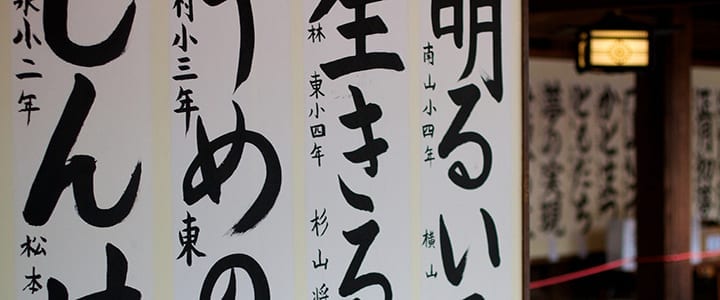When you’re taking Japanese lessons, you will be introduced to various Japanese writing systems. Here, Winston-Salem, NC teacher Willy M. explains how learning Japanese calligraphy can help you understand the Japanese alphabet…
The Japanese alphabet, or writing systems, are very different from our alphabet in English. Japanese uses more than one syllabary. A syllabary is a group of syllables that make up different words. Think of it more like a phonics system. The difference between the English phonics system and the Japanese syllabary, is that the Japanese syllabary uses different icons or images (kana) to make up the symbols that represent the sounds that the syllables make.
In addition to the syllabaries that were developed in Japan, there are also several symbols, called kanji, which were borrowed from the Chinese language. There are thousands of symbols in the Japanese language, but to keep things simple, let’s focus on two of the writing systems: hiragana and katakana.
Kana symbols come in two varieties: hiragana and katakana. Hiragana is used mainly to write indigenous Japanese words, whereas katakana is traditionally used to write non-indigenous words. In modern-day Japan, however, katakana is also commonly used in advertising, television commercials, and Japanese manga.
Studying Japanese calligraphy is a great way to learn and memorize hiragana and katakana. Here are some tips to help you get started.
Study Tools
When you start learning Japanese calligraphy, you will need some specific tools. This doesn’t mean you should run out to the store and purchase rice paper, bamboo brushes, and Japanese ink. While you will need these things eventually, the first things you should buy are a brush marker, which you can find at stores like Hobby Lobby, Michael’s or A.C. Moore, and a few packs of index cards. You can use these index cards to make flashcards, which will help you learn katakana and hiragana symbols.
Decide on a color scheme to organize your flashcards. For instance, you could use black on red for your hiragana cards, and red on black for your katakana cards. Put either a red or black border around the card to indicate which syllabary you are using (red for hiragana, black for katakana), and then draw the symbol in the middle in the opposite color.
You may want to invest in a reference book to help you learn to draw the different calligraphy symbols. “Kanji ABC: A Systematic Approach to Japanese Characters” is a great resource to learn how kanji characters work. When you take some time to look at the strokes from kanji, it helps to make sense of hiragana and katakana. Since hiragana was originally a simplified version of kanji, and katakana is a simplified form of hiragana, becoming familiar with kanji can help you understand the other two writing systems. When you look for the patterns that connect the three systems, you will begin to understand them. This will also help you with your memorization.
Here are some more resources to help you learn Japanese calligraphy:
Keep it Simple
Since these concepts can be confusing for a beginner, it’s important to simplify the process. Break the syllabaries down into smaller, manageable sections. Instead of trying to memorize an entire hiragana table, break it into groups of five. Memorize a set of five characters at a time, before you move on to the next set. Before you know it, you will have the entire syllabary memorized!
Need some extra help with the Japanese writing systems or Japanese calligraphy? Find a Japanese tutor near you!
 Willy M. teaches guitar, ukulele, and mandolin lessons in Winston, NC. He studied Japanese at Earlham college in the ’90s, which at the time, was one of the top five schools in the world for Japanese studies. He took Akido and Karate lessons while studying the Japanese language. Learn more about Willy here!
Willy M. teaches guitar, ukulele, and mandolin lessons in Winston, NC. He studied Japanese at Earlham college in the ’90s, which at the time, was one of the top five schools in the world for Japanese studies. He took Akido and Karate lessons while studying the Japanese language. Learn more about Willy here!
Photo by davidgsteadman
Maile Proctor


